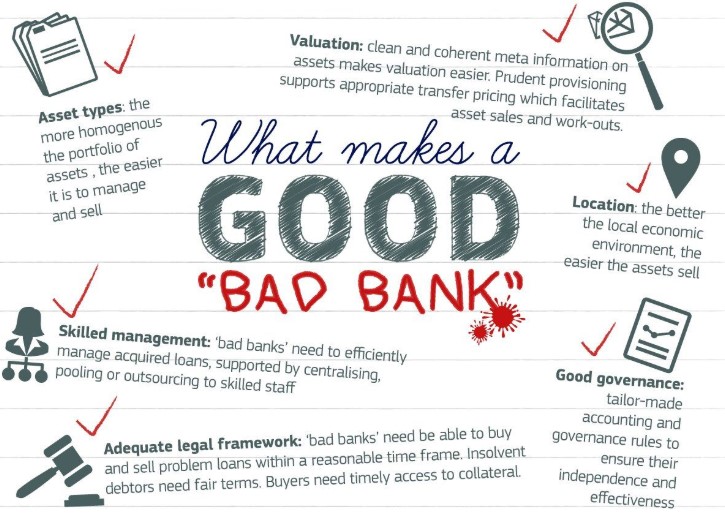Focus: GS-III Indian Economy
Why in news?
The Indian Banks Association (IBA) submitted a proposal for setting up a bad bank to the finance ministry and the RBI, proposing equity contribution from the government and the banks.
Introduction
- The idea of setting up a bad bank often comes up for debate, especially when stress in the banking sector is projected to rise in the near term.
- A slump in earnings of companies and individuals could lead to a jump in non-performing assets, reversing the early trends of NPA reduction post enactment of the Insolvency and Bankruptcy Code (IBC) and write-off of bad loans by banks.
- To tackle this upcoming challenge, the banking industry has proposed the setting up of a government-backed bad bank.
Understanding Bad Banks
- A bad bank buys the bad loans and other illiquid holdings of other banks and financial institutions, which clears their balance sheet.
- A bad bank structure may also assume the risky assets of a group of financial institutions, instead of a single bank.
- Bad banks are typically set up in times of crisis when long-standing financial institutions are trying to recuperate their reputations and wallets.
- Banks that become insolvent as a result of the process can be recapitalized, nationalized, or liquidated.
- If they do not become insolvent, it is possible for a bad bank’s managers to focus exclusively on maximizing the value of its newly acquired high-risk assets.
- Critics of bad banks say that the option encourages banks to take undue risks, leading to moral hazard, knowing that poor decisions could lead to a bad bank bailout.

What kind of NPA spike is expected down the line?
- The impact of Covid-19 and the associated policy response is likely to result in an additional debt of more than Rs. 1.5 Lakh Crores from the top 500 debt-heavy private sector borrowers turning delinquent between FY21 and FY22.
- Given that more than 10% per cent of the outstanding debt is already stressed, the proportion of stressed debt is likely to increase to almost 20% per cent of the outstanding quantum.
What is the government’s view?
- While the finance ministry has not formally submitted its view on the proposal, senior officials have indicated that it is not keen to infuse equity capital into a bad bank.
- The government’s view is that bad loan resolution should happen in a market-led way, as there are many asset reconstruction companies already operating in the private space.
- The government has significantly capitalised state-owned banks in recent years and pursued consolidation in the PSU banking space.
- These steps, along with insolvency resolution under the IBC, are seen as adequate to the tackle the challenge of bad loans.
What is the RBI view?
The central bank has so far never come out favourably about the creation of a bad bank with other commercial banks as main promoters.
Indeed, if the bad bank were in the public sector, the reluctance to act would merely be shifted to the bad bank.
Way Forward: Alternative Options
- Instead of creating a Bad Bank, infusing the capital that would be given to the bad bank directly into the public sector banks is an option.
- The enactment of (Insolvency and Bankruptcy Code) IBC has reduced the need for having a bad bank, as a transparent and open process is available for all lenders to attempt insolvency resolution.
- According to RBI, banks recovered on average more than 40% of the amount filed through the IBC in 2018-19, against just over 20% in total through the SARFAESI, Lok Adalats and Debt Recovery Tribunals.
- A model of Private Asset Management Company (PAMC) which would be suitable for sectors where the stress is such that assets are likely to have economic value in the short run, with moderate levels of debt forgiveness, can be set up.
- National Asset Management Company (NAMC) for sectors where the problem is not just of excess capacity, but possibly also of economically unviable assets in the short- to medium-term, such as in the power sector can also be set up.
What is a Non-Performing Asset (NPA)?
- A nonperforming asset (NPA) refers to a classification for loans or advances that are in default or in arrears.
- A loan is in arrears when principal or interest payments are late or missed.
- A loan is in default when the lender considers the loan agreement to be broken and the debtor is unable to meet his obligations.
How do Non-Performing Assets (NPA) Work?
- Nonperforming assets are listed on the balance sheet of a bank or other financial institution.
- After a prolonged period of non-payment, the lender will force the borrower to liquidate any assets that were pledged as part of the debt agreement.
- If no assets were pledged, the lender might write-off the asset as a bad debt and then sell it at a discount to a collection agency.
SARFAESI Act
- The Securitisation and Reconstruction of Financial Assets and Enforcement of Securities Interest Act, 2002 (also known as the SARFAESI Act) is an Indian law that allows banks and other financial institution to auction residential or commercial properties (of Defaulter) to recover loans.
- Under this act secured creditors (banks or financial institutions) have many rights for enforcement of security interest under section 13 of SARFAESI Act, 2002.
- If borrower of financial assistance makes any default in repayment of loan or any instalment and his account is classified as Non performing Asset by secured creditor, then secured creditor may require before expiry of period of limitation by written notice.
- The law does not apply to unsecured loans, loans below ₹100,000 or where remaining debt is below 20% of the original principal.
Click Here to read more about the Insolvency and Bankruptcy Code
-Source: Indian Express





